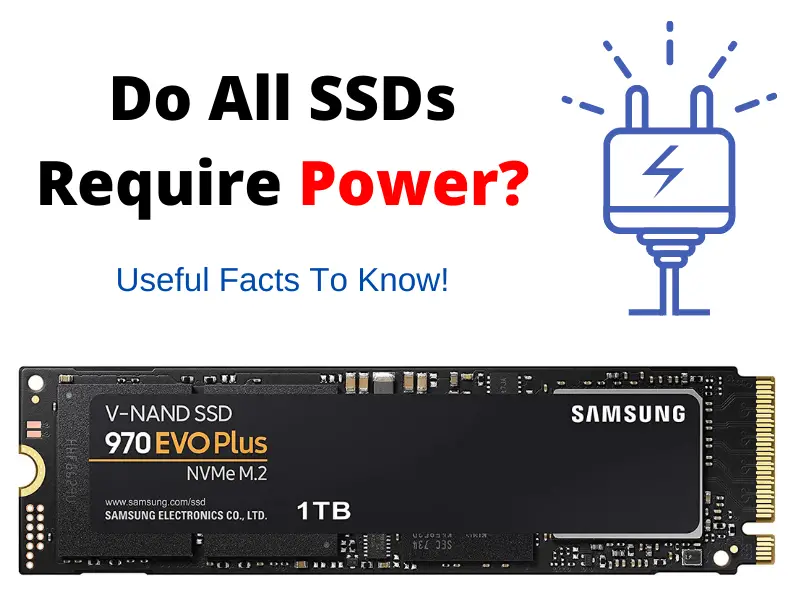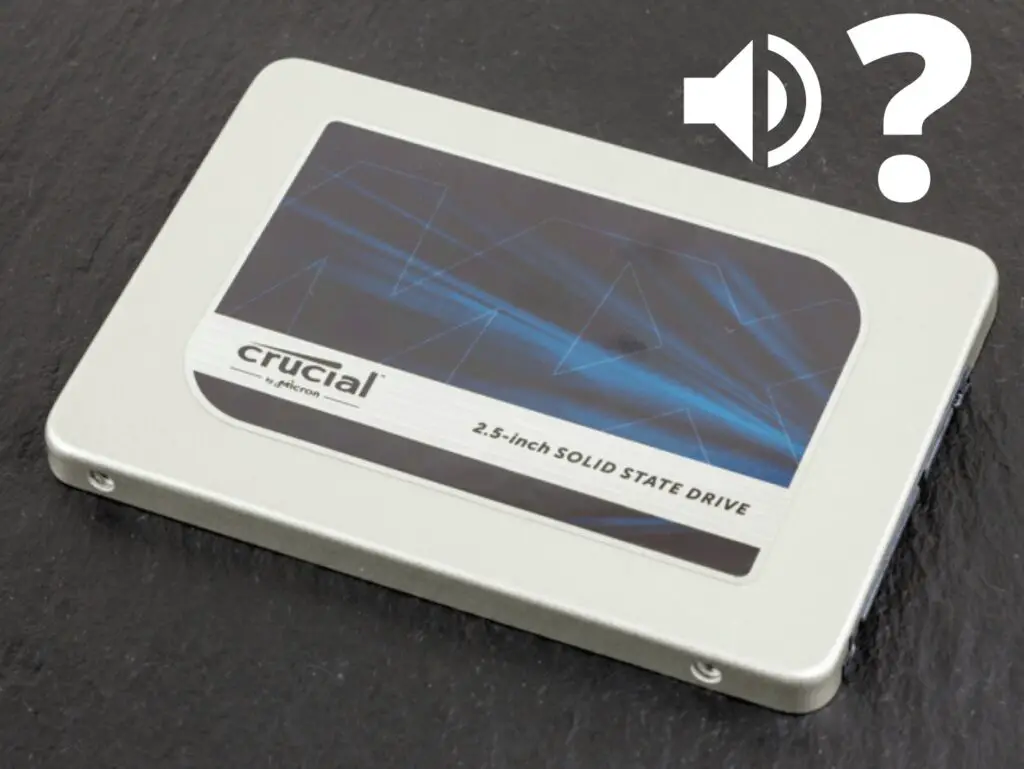A significant amount of buzz has recently come around concerning SSDs. They are the future of storage media for the foreseeable future and, there’s no denying that.
Here, we’ll highlight a few details you may be curious about regarding how they work and get powered to function.
The Facts on SSD Power Requirements
It’s imperative to keep in mind that all SSDs are electric components. This detail implies that they will always need electric power to course through their circuitry to power up and allow utilization. Depending on the type of SSD, it gets its power supplied differently.
Table of Contents

Do all External SSDs Need Power?
Any electric device requires an electric current to power it up, and an external SSD in this regard is no exception.
Let’s first consider the old-school method of creating an external drive. Computer users would buy a regular HDD and place it in a casing specialized for that function.
With that kind of setup, the HDD inside the case would still need a power source, just like it would inside your PC.
With ‘real’ external drives, the story is a little different. They have conventionally been available in a 2.5″ form factor. (Also note that SSDs are available in a 2.5″ form factor and never in a 3.5″ form factor)
The build difference in actual external drives, an external SSD in this case, presents some advantages.
External SSDs are designed for portability, and considering their smaller form factor, there are fewer components inside, thereby lowering power consumption needs.
External SSDs get their power from the USB connection to the PC. All USB ports are designed to have at a minimum of 4 contacts on board.
Two of these contacts are dedicated to handling data transfers. The other two contacts handle the power provision duties for the external SSD drive in question.
Do all Internal SSD Need Power?
SSDs are available for installation onboard your computer in two main varieties. They are the M.2 form factored SSDs, and the 2.5″ factored SSDs.
Given their difference in design, they gain connectivity to the system via different methods. Their connection methods are what essentially powers them up.
Looking at the 2.5″ form factored SSDs, they tend to act similar to HDDs when it comes to power connectivity.
From previous experience installing HDDs, you can remember that you connect it to the system using two separate cables.
One of those cables is the SATA cable, which is responsible for data transfer duties. The other is a power cable, sourcing power directly from the PSU.
This same setup is what powers up an internal SSD with a 2.5″ form factor.
For M.2 form factor SSDs, things are different for obvious reasons. Their shape is reminiscent of RAM modules, and as such, there is no room for cables. They connect to the motherboard via PCIe slots.
These types of SSDs simply need to be placed in the appropriate slot, and they’ll be ready to work. The contact between the SSD circuit and that of the PCIe slot provides power for the SSD.
How does SSD Keep Data Without Power?
Both SSDs HDDs belong to a group of memory devices referred to as non-volatile memory.
You may have heard this term being talked about when discussing RAM. RAM, in this case, is a volatile memory type. What do these terms mean?
Simply put, look at it this way. Volatility is the quality of something changing quickly. This definition implies that volatile memory is subject to rapid, constant changes, while non-volatile memory is the opposite.
If you look at how both RAM and SSDs operate, this difference becomes apparent. Both media, however, use an electrical charge to program their memory.
RAM is used to store program data and instruction of currently ongoing tasks on the computer.
When power is off, these pieces of data are lost. The RAM then becomes available to hold new program data and instructions for the new user session.
The reason for this behavior is down to the fact that a RAM’s memory cell circuit can’t hold the electrical charge to maintain the piece of memory for long periods.
SSDs, on the other hand, store data permanently, whether it is powered or not. The circuitry of the flash memory cells on the SSD allows it to hold the charges for longer periods, unlike RAM.
While the memory programming charges on the SSD cells may discharge over time, this issue can be checked on by occasionally powering up your SSD.
How Long does an SSD Last Without Power?
SSD storage is no doubt the future of storage technology. Rapid improvements and discoveries about them continue to be made every day.
An accurate description of how long they can hold data, however, has yet to be determined. The reason for this unknown property of SSDs comes down to two points.
The first reason is that no actual empirical data exists to describe the longevity of data stored on SSDs. Why? Because SSDs are expensive. No one has ever bought it and not utilized it to the fullest.
Since no one has ever bought an SSD and left it idle over several years, the data to determine the issue of data longevity isn’t available.
The second reason why an accurate description of this data doesn’t exist is that SSD technology has been rapidly changing and improving. So, it wouldn’t be accurate to compare an SSD from the 90s to the ones available now.
This difference in technology standards also creates a problem in trying to determine the accuracy of this issue.
So, even all those claims by some websites or SSD manufacturers that SSDs can last 5-10 years or even more are purely theoretical and unproven.
What can be said for sure is that the data stored on an SSD won’t last forever. The reason for this is down to how SSDs work.
Their memory circuitry uses electric charges to program memory. These charges remain in place but will start discharging soon after, thereby losing the data stored in what is referred to as disc rot.
Does an SSD Use Less Power?
In determining the answer to this question, a comparison with HDDs is in order. SSDs have different architectures compared to HDDs.
SSDs employ flash memory cells to store their data, whereas a HDD uses magnetic technology. This difference in technologies creates a difference in how they consume power.
HDDs have mechanical parts which require more power to work them.
The memory cells on SSD are fixed, and there aren’t any movable parts. So, yes, SSDs do consume less power.
The voltage requirements for each of these devices are also available from their respective packaging or seller website.
How Much Power do SSD Use?
The different build that SSDs have compared to HDDs gives them a significant edge when discussing power consumption.
For instance, a typical HDD will consume an average of 3.5 Watts of power no matter what state it is in. (State in this instance refers to whether it is in use or idling).
When it’s in use, some components need to move around, and this demands more power.
In the case of SSDs, the power consumption is lower. Their power performance sees them average less than 0.1 Watts when idling. On the other hand, when in use, they consume on average 2.5 Watts of power.
The difference in power consumption rates makes SSDs the more power-efficient choice.
It’s worth noting, however, that the exact figures may vary depending on the brand, make, and model of the SSD in question.
How Much Power Does a 2.5″ SSD Use?
The 2.5″ form factor SSD is the most available SSD option. So, for any first-time buyers or SSD newbies who want specifics about it, this bit could be useful.
These SSDs tend to consume or need an average of slightly below 4 Watts when working (writing data to them in this case).
For read operations, expect consumption rates of around 1 Watt. When idling, the power consumption drops to below 1 Watt.
How Much Power Does a NVMe SSD Use?
NVMe refers to an interface specification used to connect storage devices to the system via PCIe buses.
These types of SSDs have no cabling involved with them because of their form factor. They get their power directly from the PCIe slot where they’re placed in.
That said, these types of SSDs, require an average of slightly above 5 Watts to function. (Perform write and read operations) When idling, their power consumption drops to an average of 0.02 Watts.
How Much Power Does a M.2 SSD Use?
M.2 form factored SSDs are manufactured to a shape similar to RAM sticks. These SSDs connect to the computer via buses (known as PCIe slots) found on the motherboard.
When they are slotted in place, they are ready to be used. This slot is also what provides the power necessary for it to work.
On average, SSDs of this type typically consume 5 Watts of power when performing operations. On the other hand, when they’re idle, they consume power ranging between 0.02 and 0.05 Watts.




